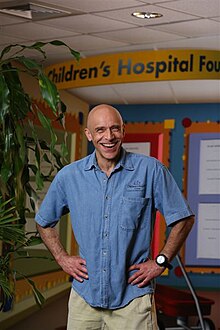Willy Fischler
Appearance
This article has multiple issues. Please help improve it or discuss these issues on the talk page. (Learn how and when to remove these messages)
|
Willy Fischler | |
|---|---|
 | |
| Born | 1949 (age 74–75) Antwerpen, Belgium |
| Nationality | dual American Belgian |
| Alma mater | Universite Libre de Bruxelles (License and Ph.D.) |
| Known for | Invisible axion, see Axion. M(atrix) theory. Gauge mediation, see Minimal Supersymmetric Standard Model |
| Scientific career | |
| Fields | Theoretical Physics |
| Institutions | University of Texas at Austin University of Pennsylvania Los Alamos National Laboratory CERN |
| Doctoral advisor | Robert Brout |
| Doctoral students | David Berenstein Xenia de la Ossa |
Willy Fischler (born 1949 in Antwerpen, Belgium) is a theoretical physicist. He is the Jane and Roland Blumberg Centennial Professor of Physics at the University of Texas at Austin, where he is affiliated with the Weinberg theory group. He is also a Licensed Paramedic with Marble Falls Area EMS and was a volunteer EMT with the Westlake Fire Department.
His contributions to physics include:
- Early computation of the force between heavy quarks.
- The invisible axion, (with Michael Dine and Mark Srednicki) as a solution to the strong CP problem.
- The cosmological effects of the invisible axion (with Michael Dine) and its role as a candidate for dark matter.
- Pioneering work (with Michael Dine and Mark Srednicki) on the use of supersymmetry to solve outstanding problems in the standard model of particle physics.
- The first formulation of what became known as the "moduli problem in cosmology" (with G.D. Coughlan, Edward Kolb, Stuart Raby and Graham Ross).
- The Fischler-Susskind mechanism in string theory (with Leonard Susskind).
- The original formulation of the holographic entropy bound in the context of cosmology (with Leonard Susskind).
- The discovery of M(atrix) theory, or BFSS Matrix Theory. M(atrix) theory is an example of a gauge/gravity duality (with Tom Banks, Steve Shenker and Leonard Susskind).
- Black Hole production in colliders (with Tom Banks).

